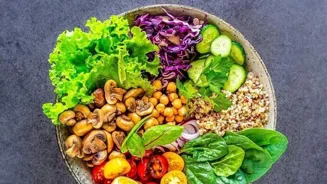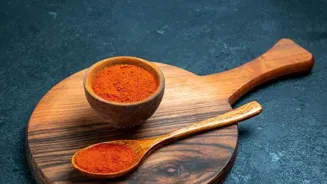Discover 7 tips for managing portion sizes in Indian-style eating. Embrace healthier habits effortlessly!
Namaste, readers! Are you also feeling like those samosas are tasting extra good these days, but
your clothes are disagreeing a bit? Don't worry, you're not alone! In India, where food is practically a love language, controlling portion sizes can feel like a real challenge.
We're used to generous servings, and saying no to a tasty dish offered by a loved one? Almost impossible! But fear not, healthy eating is totally achievable without sacrificing the joy of food. It all boils down to smart strategies.
So, let's dive into seven simple yet effective tips to manage your portion sizes, the Indian way, and embrace a healthier you!
The Plate Method: Your New Best Friend
Imagine your plate as a pie chart. According to the plate method, half of your plate should be filled with vegetables. Yes, you heard that right! Think colorful salads, deliciously spiced sabzis, or even a simple leafy green stir-fry. Fill them high!
This ensures you're getting plenty of fiber, vitamins and minerals without too many calories. Next, a quarter of your plate should be dedicated to lean protein. This could be dal (lentils), paneer (cottage cheese), chana (chickpeas), or any other plant-based protein source you enjoy.
Protein keeps you feeling full and satisfied, which prevents overeating later on.
Finally, the remaining quarter of your plate is for your carbohydrates. Think roti, rice, or even a small serving of poha or upma. The key here is moderation.
Choose whole grains whenever possible, as they're more nutritious and keep you feeling fuller for longer which will help you in the long run.
Remember, the plate method is a visual guide to help you balance your meals and control your portion sizes without having to meticulously measure every single ingredient. You can enjoy a balanced and nourishing meal while managing your health goals.
Listen to Your Tummy, Not Your Eyes
We've all been there. That enticing aroma of freshly made jalebis wafting through the air, or the sight of a beautifully decorated thali overflowing with goodies. It’s easy to get caught up in the sensory experience of food and eat more than we actually need.
It is important to remember the fact that food is our necessity and something we should be enjoying.
The actual purpose of food, which is to keep us alive is often fogotten. So, instead of letting your eyes dictate how much you eat, start paying attention to your body's hunger cues.
Before you even begin eating, take a moment to assess how hungry you actually are on a scale of 1 to 10. One being "I'm starving" and 10 being "I'm painfully full". Aim to start eating when you're around a 3 or 4, and stop when you're around a 6 or 7.
It's all about finding that sweet spot where you're comfortably satisfied, not stuffed to the brim.
Downsize Your Dishes: Small Changes, Big Impact
This trick is deceptively simple but incredibly effective. Swapping your regular-sized plates and bowls for smaller ones is a subtle way to trick your brain into thinking you’re eating more than you actually are.
It's a visual illusion that can significantly reduce your overall calorie intake without you even realizing it. Think about it: a small katori of dal looks much more substantial in a smaller bowl than it does in a large one. Likewise, a smaller plate makes a serving of rice appear more generous.
Experiment with different sized tableware and see what works best for you. You can find lots of cute, smaller-sized bowls and plates in local markets that would also just look nice! And as you begin to eat, use smaller serving spoons when dishing out your food.
This will help you control the amount you're putting on your plate in the first place. Remember, it's all about making small, sustainable changes that add up to big results over time. This one simple trick can help you enjoy your favorite Indian dishes without overdoing it.
Slow Down and Savor: Mindful Eating is Key
In today's fast-paced world, we often eat our meals in a hurry, barely even tasting the food. We gobble down our lunch at our desks, wolf down our dinner while watching TV, or mindlessly munch on snacks straight from the jar during the intervals.
By practicing slow and mindful eating, you can savor the flavors and enjoy the experience of eating.
Think of the way an artist creates a work! To practice this simple eat, remove all distractions, turn off the TV and your mobile phone and focus solely on your food.
Take small bites, chew your food thoroughly, and pay attention to the taste, texture and aroma. Even talking a break in between your meal to take small breathers helps.
By eating slowly, you give your brain time to register that you're full, preventing you from overeating as it takes time for your brain to get signals. So, slow down, savor each bite, and enjoy the present.
Beware of "Buffet Brain": Strategize Your Approach
The word buffet is usually associated with happiness and joy, especially the unlimited variety! But if you're trying to manage your portion sizes, buffets can be a total battlefield.
The sheer variety of food on display can be overwhelming, leading to "buffet brain," where you pile your plate high with everything in sight. To combat this, strategize your approach. Before you even pick up a plate, take a walk around the buffet and survey of all the options.
Then, make a conscious decision about what you really want to eat, and stick to it. Start with a small plate and only fill it with a few selected items. Focus on filling half of your plate with vegetables, as recommendes, a quarter with your protein and the last quarter with your carbohydrate.
Resist the urge to try everything, and remember that it's okay to go back for seconds if you're still hungry, but still start with a smaller approach! With a little planning, you can enjoy the fun of a buffet without completely throwing your healthy eating habits out the window.
Pre-portioned Snacks: Avoid the Temptation
Mid-meal cravings can be a major downfall when it comes to portion control. Staring at that big jar of namkeen or reaching for a handful of biscuits from the box can easily lead to mindless snacking and excess calories.
One simple solution is to pre-portion your snacks into smaller containers or baggies. Instead of grabbing the entire jar of biscuits, allocate a serving into a small bowl.
This way, you can enjoy your snack without the temptation of overeating.
Choose healthy snack options like fruit, nuts, or yoghurt. These snacks will satisfy your cravings without derailing your diet. When choosing processed snacks, pay attention to the serving size on the nutrition label and portion them accordingly.
With a little bit of planning, you can manage your snacking habits and keep your portion sizes in check.
Stay Hydrated: Water is Your Ally
Last but not least, never underestimate the power of water when it comes to manage your weight and portions! Drinking enough water throughout the day can not only keep you hydrated but also helps to feel full. Often, we mistake thirst for hunger, leading to unnecessary snacking or overeating.

Before reaching for a snack, try drinking a glass of water and waiting for a few minutes. You might find that you were simply thirsty and the hunger pangs disappear.
Aim to drink at least eight glasses of water a day, and even more if you're physically active.
You can also incorporate healthy beverages like herbal teas or homemade lemonade into your routine. But remember, avoid sugary drinks like juices and fizzy drinks, as they can add a lot of unnecessary calories and do the exact opposite of your goal.
So, remember the benefits of being hydrated is as important as eating healthy!
AI Generated Content. Glance/InMobi shall have no liability for the content









